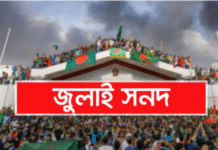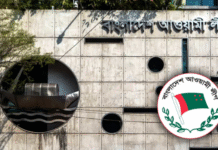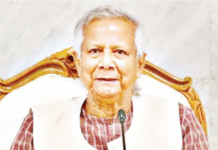
As dawn breaks and the first rays of sunlight streams through your window, you hear the rhythmic beat of drums and the joyful clanging of cymbals coming from a nearby temple.
It’s time for celebration. It’s time for Durga Puja.
As you step onto your balcony, you see young people in vibrant new clothes going toward the mandaps. They spread the joyful spirit of the celebration to everyone around, with their laughter and excitement.
You notice a husband lovingly placing a sindoor (vermilion) on his wife’s forehead — a small but meaningful act of devotion.
As you walk down the street, a middle-aged woman offers you slices of sweet fruits. Nearby, a priest asks, “Have you taken the prasad (offerings)?”
These interactions are not just passing moments; they capture the spirit of Durga Puja, the grandest festival for Bangalee Hindus, filling the streets with life and energy during this vibrant Ashwin month.

This year, Durga arrived on a “palki” (palanquin), symbolising challenging times.
Her departure will be bittersweet, as she will ride back on a horse, a sign of unrest and instability.
Durga Puja began last Wednesday with Mahashashti, but tomorrow, the joyous celebration will come to an end. Yet, in these few days, the festival has been a unifying force, bringing together people from all walks of life.
During visits to various areas of the city on Wednesday morning, the excitement was clear as devotees gathered for Shashti puja, welcoming the goddess with open hearts. Mahasaptami falls on Thursday, and though it wasn’t initially a holiday, the government declared it one, adding extra joy to the celebrations.

On Mahasaptami, rituals bridged the earthly and divine as the goddess was bathed and dressed. Devotees offered flowers at her feet, fasted in her honour, and drank the sacred Charanamrita, believed to purify the soul.
As time passed, the main rituals of Durga Puja began, and the city became even more lively. The sound of drums filled the air, while devotees gathered at the beautifully decorated puja pavilions, each one a display of art and devotion.

In Dhaka, major temples like Dhakeshwari, Ramna Kali, and Swamibagh came alive with the sounds of drums, chants, and joyful devotees. The diverse crowd, filled with people of all ages, reflected the community spirit, and even larger gatherings were expected by evening.
On Thursday morning at the Dhakeshwari National Temple, this newspaper met Ratul Roy and his wife, Radhika Roy, who live in Shantinagar.
Ratul shared their plan to visit pavilions in Dhanmondi, Khamarbari and Banani.

“The crowds are smaller on Saptami,” he explained, “so we thought it was the perfect time to explore.”
While we talked to Ratul, we overheard another conversation about arranging transportation to Narayanganj.
Ashish Haldar, a resident of Lalbagh, was on the phone with a car rental service, planning a family trip to enjoy the puja in Narayanganj that night. “Every year on Saptami, we visit Narayanganj,” he said with excitement. “It has become a tradition for us. This year, with the public holiday, we’re even more thrilled!”

The festival’s excitement grew stronger with Friday’s Mahashtami, bringing a mix of urgency and reverence. The day featured the sweet aroma of prasad, shared among devotees, and a lively aarti competition before the solemn Sandhi Puja in the evening.
The Kumari Puja, held at the Ramakrishna Mission in Dhaka, is one of the most cherished parts of Durga Puja. There, a young girl is dressed as goddess Durga, symbolising purity and divinity.
Devotees gather to chant mantras and offer blessings, creating an atmosphere of joy and spirituality. The Kumari is given different names as she grows — Sandhya, Saraswati, Tridharmurti, Kalika, and many more, reflecting her divine journey.
Worshipping the Kumari fosters a sense of maternal affection, connecting everyone to the divine feminine energy.

Crowds fill the courtyard and streets, with increased security ensuring the safety of all attendees.
Today is Nabami, the ninth lunar day, marked by the Maha Nabami Puja taking place across the country. With prayers of “Mother, come back again,” the Hindu community prepares to say goodbye to the goddess tomorrow. Though she returns to Kailash, her spirit will stay with her devotees, and in the afternoon, the three goddesses will be honoured with special worship.
As the day ends, the clay idols are immersed in water, marking a tender farewell.
Devotees, with tearful eyes and loving hearts, softly pray, “Come back again next year, mother”.
Daily Star









